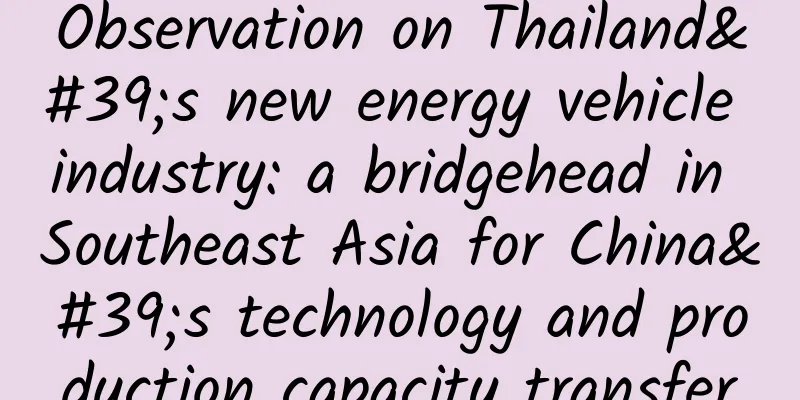Observation on Thailand's new energy vehicle industry: a bridgehead in Southeast Asia for China's technology and production capacity transfer

|
On September 17, Avita Motors held a brand launch conference in Bangkok, Thailand, announcing its official entry into the Thai market. According to the Avita brand, deepening its presence in the Thai market is an important step in its globalization strategy. Before Avita, domestic manufacturers such as BYD, SAIC, Nezha, Changan, GAC, and Great Wall have already established their presence in the Thai market. In many people's impressions, Thailand is a small country, so why do Chinese new energy vehicles choose Thailand when going overseas? The reason is simple. Although Thailand is small, it plays an important role in the global automobile industry and new energy vehicle industry, and can be called a bridgehead in Southeast Asia. In terms of GDP, Thailand is not the leader in ASEAN, but it is the largest automobile producer in Southeast Asia, with an annual automobile output of about 2 million vehicles. It is also a relatively mature automobile consumer market. In 2023, Thailand's annual automobile sales were about 775,000 vehicles, making it a major automobile country in Southeast Asia. At the same time, Thailand also has an important position in new energy vehicles. More importantly, it is somewhat similar to China's new energy vehicle market. In 2023, the sales volume of pure electric vehicles in Thailand reached 76,314, accounting for about 10% of the total automobile sales. From the perspective of total volume, this number does not seem to be excellent. However, it should be noted that the sales volume of electric vehicles in Thailand in 2022 was less than 10,000, and the sales volume in 2023 was equivalent to 7.8 times that of 2022. This growth rate even exceeded that of China a few years ago, which can be said to be unstoppable. In 2023, among the top 10 new energy vehicle sales in Thailand, two are from Tesla, namely Model 3 and Model Y, and the remaining 8 are Chinese brands, including BYD, Nezha, Great Wall, MG, etc. It is worth mentioning that the domestic new energy vehicle models that are in the top 10 of the sales list are generally priced at a relatively high level. For example, the domestic 100,000-level BYD Yuan PLUS is priced at 178,000 yuan in the Thai market. In addition, some models that perform generally in China are shining in the Thai market, such as Nezha V, Ora Good Cat, MG 4, etc. This situation proves that Thailand's new energy vehicle market is still in its infancy and is far from mature. From the market share, it can be seen that the Thai new energy vehicle market is basically monopolized by Chinese manufacturers. In 2023, the market share of Chinese brands reached 83.9%, and further increased to 87.1% from January to May 2024, which is higher than the domestic market share. Among them, BYD's share reached an astonishing 41.4%, which also exceeded the domestic market share. Apart from Chinese brands, the only one that can enter the mainstream market is Tesla, with a market share of about 6.1%. Japanese manufacturers, which occupy 83% of the Thai fuel vehicle market, have a share of less than 1% in the new energy market. Volkswagen, Ford, General Motors and other manufacturers have almost no performance in Thailand's new energy market. In terms of policy, Thailand is relatively stable. As early as 2021, the Thai government introduced the "Double 30" policy, which means that 30% of cars produced in Thailand must be zero-emission electric vehicles before 2030. In addition, the Thai government has set a goal of 1.35 million electric vehicle sales by 2035. Like the Chinese market, Thailand's new energy vehicle market also has a subsidy policy. According to the Thai government's EV 3.0 plan, between 2022 and 2025, electric vehicles with a price of less than or equal to 2 million baht and a battery capacity of more than 30 degrees can enjoy a subsidy of 150,000 baht per vehicle; in addition, some electric vehicles that meet the standards can also enjoy a maximum of 20% import tariff exemption and a reduction in consumption tax from 8% to 2%. Thailand's new energy vehicle industry policy is also forward-looking. According to the second phase of electric vehicle incentives (EV 3.5 policy) released by the Thai government in November 2023, for automobile manufacturers producing new energy vehicles in Thailand, the ratio of imported vehicles to locally produced vehicles should reach 1:2 in 2026, and further reach 1:3 in 2027. It is obvious that Thailand also has plans and ambitions in the field of new energy vehicles. The purpose of such policies is to stimulate global new energy vehicle manufacturers to invest and set up factories in Thailand and obtain a relatively complete new energy vehicle industry chain. Judging from the current situation, Chinese new energy vehicle manufacturers are the ones that best meet the requirements of the Thai government. Both their technological strength and sales volume are enough to make Chinese manufacturers the dominant force in the Thai market. Currently, seven Chinese car companies have entered the Thai market and have established a closed loop from planning, production to sales. Among them, BYD has an annual production capacity of 150,000 vehicles, Great Wall's current annual production capacity in Thailand reaches 80,000 vehicles, Nezha Auto reaches 20,000 vehicles, Changan Automobile plans an annual production capacity of 200,000 vehicles, and Chery's long-term production capacity plan reaches 100,000 vehicles. Along with new energy vehicle manufacturers, various parts suppliers have also entered Thailand, the most important of which are power battery manufacturers. BYD's factory in Thailand itself has a power battery project. According to the Thai Board of Investment, Chinese power battery manufacturers such as CATL, AVIC Lithium, EVE Energy, Guoxuan High-tech, Sunwoda, and Honeycomb Energy are all considering Thailand as a battery production base. This is exactly what the Thai government wants to see. As a small country, Thailand does not intend to compete with China, the United States, and Europe in terms of sales, but it has signed free trade agreements with Australia, New Zealand, and other Southeast Asian countries, and very much hopes to become a transit point for major manufacturers to enter the Southeast Asian and even European and American markets. However, the development of new energy vehicles in Thailand has also encountered a series of challenges, one of the most important of which is the lack of charging infrastructure. According to the data from the Electric Vehicle Association of Thailand, the incremental ratio of cars to charging piles in Thailand in 2023 is about 1:18.8. In comparison, the incremental ratio of cars to charging piles in China in 2023 is 1:2.4. The problems of difficult and slow charging are still prominent in the new energy market in Thailand, which is very similar to the situation in China a few years ago. There is no other economy like China in the world. China's new energy vehicle market dominates the world, relying on strong industrial policies, first-class core technologies, a huge domestic consumer market, a strong industrial base, and well-trained industrial workers. If Thailand can meet 1-2 of these requirements, it will be enough to get started in the new energy vehicle market. As a winner of Toutiao's Qingyun Plan and Baijiahao's Bai+ Plan, the 2019 Baidu Digital Author of the Year, the Baijiahao's Most Popular Author in the Technology Field, the 2019 Sogou Technology and Culture Author, and the 2021 Baijiahao Quarterly Influential Creator, he has won many awards, including the 2013 Sohu Best Industry Media Person, the 2015 China New Media Entrepreneurship Competition Beijing Third Place, the 2015 Guangmang Experience Award, the 2015 China New Media Entrepreneurship Competition Finals Third Place, and the 2018 Baidu Dynamic Annual Powerful Celebrity. |
>>: New system vulnerability makes iOS 10 easier to break into, Apple says it has started fixing it
Recommend
How was the NetEase Cloud Music subway screen-sweeping incident planned?
Yesterday, two red hot spots appeared: the spread...
5 steps to teach you how to quickly get started with Weibo channel operations
As the gossip center of the entire Internet, Weib...
Does iPhone support Beidou?
[[332078]] What is Beidou? We all use mobile phon...
Solid info! Six aspects that a complete operation plan should include
Anyone who does operations will know that there a...
Basic knowledge points you must know about App operation and promotion!
For most apps, more than 50% of their traffic come...
The inside story of Android market promotion channels and tips on how to avoid pitfalls!
What I want to share with you today is the Androi...
Two Audi 4S stores in Beijing and Zhengzhou have successively switched to Wenjie, and BBA's offline base has begun to shake
The competition in the automotive industry is far...
How to borrow money using social security card? Social Security Card Loan Process
How to borrow money using social security card? T...
Google VR: Anything above 9.9 yuan is just a tax
If you ask me, do I have any special feeling afte...
Apple plans to establish a new supply chain in the country: exclusively for iPhones in the Chinese market
DigiTimes released a report today highlighting th...
3 ways to improve user retention through APP operation!
With the disappearance of the Internet's demo...
The three laws of traffic products
Why can Waipojia’s Mapo Tofu be sold for as low a...
A brief discussion on APP operation and promotion: How to place advertisements accurately?
Preface: As of the end of March this year, accord...
Shenzhou's naked attack on Uber: poor marketing without regard for appearances
Sometimes the difference between good marketing a...
How to use Baidu's active push? How to use cygwin active push correctly?
How to use Baidu's active push? How to use cy...









